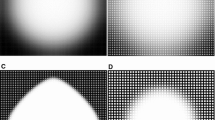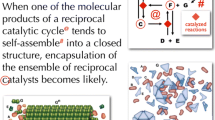Abstract
An enduring mystery in biology is how a physical entity simple enough to have arisen spontaneously could have evolved into the complex life seen on Earth today. Cairns-Smith has proposed that life might have originated in clays which stored genomes consisting of an arrangement of crystal monomers that was replicated during growth. While a clay genome is simple enough to have conceivably arisen spontaneously, it is not obvious how it might have produced more complex forms as a result of evolution. Here, we examine this possibility in the tile assembly model, a generalized model of crystal growth that has been used to study the self-assembly of DNA tiles. We describe hypothetical crystals for which evolution of complex crystal sequences is driven by the scarceness of resources required for growth. We show how, under certain circumstances, crystal growth that performs computation can predict which resources are abundant. In such cases, crystals executing programs that make these predictions most accurately will grow fastest. Since crystals can perform universal computation, the complexity of computation that can be used to optimize growth is unbounded. To the extent that lessons derived from the tile assembly model might be applicable to mineral crystals, our results suggest that resource scarcity could conceivably have provided the evolutionary pressures necessary to produce complex clay genomes that sense and respond to changes in their environment.








Similar content being viewed by others
Notes
In growth that proceeds downward, rather than upward, the tiles labelled resource tiles function as measurement tiles, and vice versa. Thus, both assemblies that can predict the resource tile types that are available from the measurement tiles, and those that can predict the measurement tile types that will be available from the current concentration of resource tiles will be selected for. Note, however, that gate types may be non-deterministic during downward growth, which could result in crystal growth stalling when a tile is incorporated that creates a binding site that matches no gate tile’s outputs. Therefore, consideration of downward growth rates is necessary for a complete evaluation of a crystal’s fitness; but we neglect it here to simplify the presentation.
This estimate assumes that since Δt ≫ s, at any particular time the resource and measurement tile concentrations are uncorrelated. So half the time, the resource and measurement tiles are compatible, and the crystal grows at a rate of D + 1 seconds per zig-zag; and half the time the resource and measurement tiles are not compatible, and the crystal essentially doesn’t grow.
Note that counters whose natural period is slightly less than the period of the environment will easily remain synchronized with the environment, even when there is variation in the arrival times of the tiles being added.
While zig-zag assemblies copy layers on both growth fronts, for the purposes of our argument, we will assume that computation on zig-zag assemblies proceeds in only one direction (upward). While this is not necessarily so for the tile sets we describe, growth can be restricted to one direction by using a transformed tile set (Winfree 2006) that uses extra tiles to prevent growth in the wrong direction.
In cases where a complete shape is necessary for selective advantage, it is also possible to use a construction where crystals can grow forward as well as backward, so that the parent crystal can grow back the piece of the shape that was lost during splitting (Winfree 2006).
References
Barish RD, Rothemund PWK, Winfree E (2005) Two computational primitives for algorithmic self-assembly: copying and counting. Nano Lett 5:2586–2592
Bedau MA, McCaskill JS, Packard NH, Rasmussen S, Adami C, Green DG, Ikegami T, Kaneko K, Ray TS (2000) Open problems in artificial life. Artif Life 6(4):363–376
Blum M (1967) A machine-independent theory of the complexity of recursive functions. J ACM 14:322–336
Bowden N, Terfort A, Carbeck J, Whitesides G (1997) Self-assembly of mesoscale objects into ordered two-dimensional arrays. Science 276:233–235
Cairns-Smith AG (1966) The origin of life and the nature of the primitive gene. J Theor Biol 10:53–88
Cairns-Smith AG (1982) Genetic takeover and the mineral origins of life. Cambridge University Press
Cairns-Smith AG, Hartman H (1986) Clay minerals and the origin of life. Cambridge University Press
Chen H-L, Goel A (2004) Error free self-assembly using error prone tiles. In DNA Computing 10, Berlin Heidelberg, Springer-Verlag
Chworos A, Severcan I, Koyfman AY, Weinkam P, Oroudjev E, Hansma HG, Jaeger L (2004) Building programmable jigsaw puzzles with RNA. Science 306:2068–2072
Collins SR, Douglass A, Vale RD, Weissman JS (2004) Mechanism of prion propagation: amyloid growth occurs by monomer addition. PLoS Biol 2:e321
Cook M, Rothemund PWK, Winfree E (2004) Self-assembled circuit patterns. In: Chen J, Reif J (eds) DNA Computing 9, volume LNCS 2943. Springer-Verlag, Berlin Heidelberg, pp 91–107
Eigen M (1971) Self-organization of matter and evolution of biological macromolecules. Naturwissenschaften 58(10):465–523
Ekani-Nkodo A, Kumar A, Fygenson DK (2004) Joining and scission in the self-assembly of nanotubes from DNA tiles. Phys Rev Lett 93:268301
Fygenson DK, Flyvbjerg H, Sneppen K, Libchaber A, Leibler S (1995) Spontaneous nucleation of microtubules. Physical Review E 51:5058–5063
Hanczyc MM, Fujikawa SM, Szostak JW (2003) Experimental models of primitive cellular compartments: encapsulation, growth, and division. Science 302:618–622
Joyce GF (2004) Directed evolution of nucleic acid enzymes. Annu Rev Biochem 73:791–836
Lagoudakis MG, LaBean TH (2000) 2-D DNA self-assembly for satisfiability. In: Winfree E, Gifford DK (eds) DNA based computers V, volume 54 of DIMACS. American Mathematical Society, Providence, RI, pp 141–154
Levin LA (1973) Universal sequential search problems. Probl Inf Transm 9:265–266
Mao C, LaBean TH, Reif JH, Seeman NC (2000) Logical computation using algorithmic self-assembly of DNA triple-crossover molecules. Nature 407(6803):493–496
Pitsch S, Eschenmoser A, Gedulin B, Hui S, Arrhenius G (1995) Mineral induced formation of sugar phosphates. Orig Life Evol Biosph 25(4):297–334
Reif JH, Sahu S, Yin P (2004) Compact error-resilient computational DNA tiling assemblies. In DNA Computing 10, Berlin Heidelberg, Springer-Verlag
Rothemund PWK (2000) Using lateral capillary forces to compute by self-assembly. Proc Natl Acad Sci 97:984–989
Rothemund PWK, Papadakis N, Winfree E (2004) Algorithmic self-assembly of DNA Sierpinski triangles. PLoS Biol 2:424–436
Rothemund PWK, Winfree E (2000) The program-size complexity of self-assembled squares. In Symposium on Theory of Computing (STOC), pages 459–468 ACM,
Schulman R, Winfree E (2005) Self-replication and evolution of DNA crystals. In Advances in Artificial Life, 8th European Conference, volume 3630. Springer-Verlag, Berlin Heidelberg, pp 734–743
Sipser M (1997) Introduction to the theory of computation. PWS Publishing Company
Solomonoff RJ (1964) A formal theory of inductive inference: Part 1 and 2. Inf Control 7:(1–22)224–254
Soloveichik D, Winfree E (2004) Complexity of self-assembled scale-invariant shapes. In: DNA Computing 10.Berlin Heidelberg, Springer-Verlag
Wang H (1962) An unsolvable problem on dominoes. Technical Report BL-30 (II-15), Harvard Computation Laboratory
Watanabe S (1961) 5-symbol 8-state and 5-symbol 6-state universal Turing machines. J ACM 8:476–483
Winfree E (1996) On the computational power of DNA annealing and ligation. In: Lipton RJ, Baum EB (eds) DNA based computers, volume 27 of DIMACS. American Mathematical Society, Providence, RI, pp 199–221
Winfree E (1998) Simulations of computing by self-assembly. Technical Report CS-TR:1998.22, Caltech
Winfree E (2006) Self-healing tile sets. In: Chen J, Jonoska N, Rozenberg G (eds) Nanotechnology: science and computation, Springer
Winfree E, Bekbolatov R (2004) Proofreading tile sets: Error-correction for algorithmic self-assembly. In: Chen J, Reif J (eds) DNA computing 9 volume LNCS 2943. Springer-Verlag, Berlin Heidelberg, pp 126–144
Winfree E, Liu F, Wenzler LA, Seeman NC (1998) Design and self-assembly of two-dimensional DNA crystals. Nature 394:539–544
Wright MC, Joyce GF (1997) Continuous in vitro evolution of catalytic function. Science 276:614–617
Yokobayashi Y, Weiss R, Arnold FH (2002) Directed evolution of a genetic circuit. Proc Nat Acad Sci USA 99:16587–16591
Acknowledgments
We thank Andrew Turberfield, Paul Rothemund, Robert Barish, Ho-Lin Chen, and Ashish Goel for insightful conversations and suggestions. This work was supported by NASA Grant No. NNG06GA50G.
Author information
Authors and Affiliations
Corresponding author
Rights and permissions
About this article
Cite this article
Schulman, R., Winfree, E. How crystals that sense and respond to their environments could evolve. Nat Comput 7, 219–237 (2008). https://doi.org/10.1007/s11047-007-9046-8
Received:
Accepted:
Published:
Issue Date:
DOI: https://doi.org/10.1007/s11047-007-9046-8




